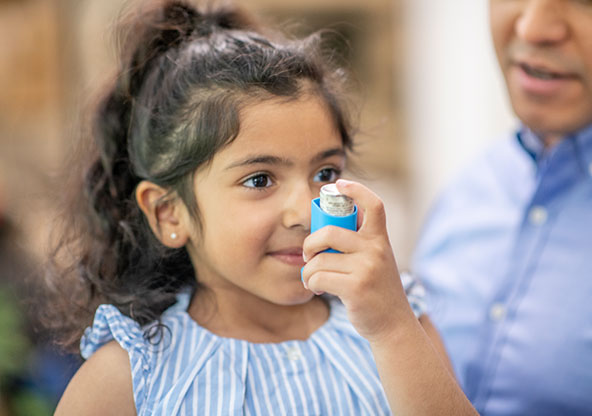Does Your Child Have an Asthma Action Plan?
Dr. Tarak Patel, a certified expert in children's lung and sleep disorders at CHRISTUS Children's, highlights the significance of an asthma action plan. He explains how it can be a powerful tool in managing your child's asthma effectively.
What is an Asthma Action Plan?
An Asthma Action Plan helps patients manage their asthma and avoid hospitalization or emergency room visits.
The plan helps children and their parents and guardians:
- It explains all the medicines they need.
- It shows when and how to take medicines.
- It helps control asthma for a long time.
- It gives a plan if asthma gets worse.
Revisiting Asthma Plans for Back-to-School
Schools often ask kids with asthma to have a plan. This plan helps kids and parents handle asthma and tells school nurses what to do if a kid has asthma symptoms.
- Older kids, like those in middle school, can bring inhalers.
- For little kids, the inhaler and a tool called a spacer are usually kept in the school's medicine cabinet. They can use these when they need to.
- It's important for parents to share this plan with the school and to update it if the doctor changes the child's asthma treatment.
Recognizing the Symptoms
Asthma is a broad diagnosis, and its symptoms can vary. However, some common signs should prompt parents to consider whether their child might have asthma.
Symptoms include:
- A cough that lasts for more than two weeks
- A dry cough that persists with exercise
- Shortness of breath
- Chest tightness
- Wheezing
If your child has visited the ER multiple times for persistent coughs or requires nebulizer treatments, it might be time to consult a specialist.
General Guidelines on Creating a Written Plan
Creating a written asthma action plan with your child is crucial in managing their asthma effectively.
However, it is critical to consult with a healthcare professional. Your child's healthcare provider can give you a template for the plan and guide you on what to include based on your child's specific needs and the severity of their asthma.
Here are general steps to make a plan:
1. Understand the Zones: An asthma action plan typically includes three zones: green, yellow, and red, each representing different levels of asthma control.
- The Green Zone represents good control of asthma. It includes information on what medications your child should take when feeling well.
- The Yellow Zone represents caution for your child experiencing mild to moderate asthma symptoms. It includes instructions on what additional medications to take and when.
- The Red Zone represents a medical alert for when your child is experiencing severe symptoms. It includes instructions on what emergency medications to take and when to seek immediate medical attention.
2. Include Medication Details: For each zone, list the medications your child should take, the dosage, and the frequency. Also, include information on how to use the medication, such as an inhaler or nebulizer.
3. Identify Triggers: Include a list of triggers that can worsen your child's asthma and steps to avoid them. Common triggers include allergens, cold air, exercise, and respiratory infections. Emergency
4. Contact Information: Include contact information for your child's healthcare provider, the nearest emergency room, and other important contacts.
5. Review the Plan with Your Child: Review the plan with them depending on your child's age and maturity level. Ensure they understand what each zone means, what medications they should take, and when to seek help.
6. Share the Plan: Share the plan with anyone caring for your child, including teachers, school nurses, babysitters, and family members.
7. Regularly Update the Plan: Asthma symptoms and triggers can change. Review and update the plan regularly, especially after doctor visits or hospitalizations.
Remember, an asthma action plan is a living document; you should update it as your child's condition changes.
The plan helps you manage your child's asthma and communicate effectively with healthcare providers and caregivers.
Who Can See My Child for Asthma Attacks?
Various health professionals can manage asthma in children, depending on the severity of the condition and the child's specific needs. Here are a few types of healthcare professionals who might be involved in the care of a child with asthma:
- Pediatricians: These doctors specialize in the health of infants, children, and teenagers. They can diagnose and manage asthma in children, prescribe medications, and provide advice on managing triggers and symptoms.
- Pediatric Pulmonologists: These pediatricians have undergone additional training to specialize in lung diseases, including asthma, in children. Patients should seek a pulmonologist's care for more severe or difficult-to-control cases of asthma.
- Allergists/Immunologists: These doctors specialize in allergies and the immune system. Since allergies often trigger asthma, these specialists can be very helpful in managing asthma. They can perform allergy testing and provide treatment options like immunotherapy.
- Family Physicians: These doctors care for patients of all ages, including children. They can diagnose and manage asthma and refer to specialists if necessary.
- Nurse Practitioners and Physician Assistants: These professionals can also provide care for children with asthma under the supervision of a physician. They can diagnose the condition, prescribe medications, and provide education on managing the disease.
- Respiratory Therapists: These are healthcare professionals trained in managing conditions that affect breathing. They can provide education on proper inhaler techniques and other aspects of asthma management.
Remember, having a good healthcare team that can work together to manage a child's asthma effectively is important. Regular check-ups and communication with the healthcare team are key to controlling asthma.
For more information or to schedule an appointment, visit Christus Pediatric Pulmonology. Let's ensure a smooth back-to-school transition for your child.

